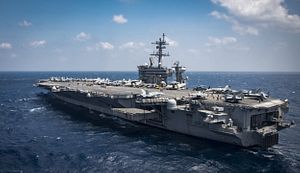The Center for Strategic and International Studies has developed a tool for projecting the cost, size, and construction time of different visions of the future U.S. naval fleet. The tool projects to 2046, and allows users to play with a variety of different ship types and fleet configurations. The tool remains in beta, and has a number of twitchy bugs, but nevertheless represents a fascinating contribution to the conversation on fleet composition. The basic ship types include U.S. Navy Ford-class carriers (CV), Arleigh Burke Flight III destroyers (DD), Littoral Combat Ship and LCS based frigates (FFG), Virginia-class subs (SSN), Ohio-class ballistic missile subs (SSBN), America-class amphibs (LHA), San Antonio-class docks (LPD), LXR landing ships (LSD), and a variety of support and logistical vessels.
Here are some fleets I worked out, built against the baseline assumption of a 2046 fleet (10 CV, 80 DD, 45 FF, 51 SSN, 12 SSBN, 11 LHA, 11 LPD, 11 LSD, 29 logistics, 32 support):
Constabulary Fleet (6 CV, 32 DD, 150 FFG, 40 SSN, 12 SSBN, 16 LHA, 22 LPD, 16 LSD, 60 logistics, 70 support): This force maxes out on lower level capabilities in an effort to provide a force capable of problem-solving around the world, from fighting piracy to humanitarian assistance to general “presence” patrols. This would increase the 30 year projection by about $40 billion.
Fighting Fleet (12 CV, 90 DD, 12 FFG, 100 SSN, 12 SSBN, 8 LHA, 8 LPD, 8 LSD, 36 logistics, 48 support): This fleet, heavy on large surface combatants and attack submarines, is designed to fight and win a naval war against a peer competitor. It would add some $280 billion to the baseline shipbuilding cost projection by 2046.
China Fleet (4 CV, 28 DD, 50 FFG, 75 SSN, 4 SSBN, 4 LHD, 6 LPD, 8 LSD, 20 logistics, and 30 support): This fleet tries to achieve parity with the PLAN (at its current size) would include. This fleet would save some $400 billion over the 30 year period. Useful not so much as a realistic projection as for an understanding of the USN’s direct competitor.
The Forward… From the Sea Fleet (8 CV, 50 DD, 60 FFG, 30 SSN, 12 SSBN, 18 LHA, 18 LPD, 18 LSD, 30 logistics, 42 support): This force is optimized for strike and expeditionary operations. It retains high-end carrier capabilities, but reduces the overall SSN and DD fleets in favor of amphibious vessels and Littoral Combat Ships. Altogether, this saves the USN around $120 billion under baseline.
The Deterrent Fleet (4 CV, 20 DD, 20 FFG, 72 SSN, 24 SSBN, 6 LHA, 6 LPD, 4 LSD, 20 logistic, 20 support): This force would take an approach similar to the Russians over the past two decades; concentrate on the strategic deterrent, while letting world-spanning offensive capabilities wither. We can imagine the USN settling in this direction in the wake a decision to decommission the non-naval aspects of the nuclear triad (bombers, ICBMs) in favor of the sea-based nukes. This fleet would cost around $285 under baseline by 2046.
Minimal fleet (4 CV, 20 DD, 12 FFG, 24 SSN, 4 SSBN, 4 LHA, 6 LPD, 4 LSD, 12 logistics, 16 support): This represents the minimum plausible fleet still capable of undertaking operations in defense of US coasts and sea lanes. Savings would amount to some $850 billion.
Maximal Fleet (15 CV, 99 DD, 135 FG, 105 SSN, 16 LHD, 16 LPD, 16 LSD, 85 logistics, 105 support): Resembling the never-achieved 600 Ship Navy of the 1980s this force would add roughly $1 trillion to the shipbuilding and operations budget over the next thirty years. It is also probably the only force capable of maintaining the extant level of naval domination that the US Navy currently enjoys.
The tool has some of the drawbacks associated with all predictive models (see accompanying post). Still, with the basic framework established, it would be fascinating to see CSIS develop models that could project Chinese, Japanese, or European fleet development.
This post is the first in a two-part series.

































